On Tuesday, August 3rd, Welden Owen and Insight Editions are releasing a new coffee table book all about the distinctive midcentury modern style of Star Trek: The Original Series. TrekMovie had an exclusive look at what’s inside and a chance to speak with authors Dan Chavkin and Brian McGuire about what it took to put together this unique book.
Star Trek: Designing the Final Frontier
Not only did the original Star Trek launch a venerable sci-fi franchise, it also set a new standard for design and aesthetics. The new book Star Trek: Designing the Final Frontier is a thorough investigation of the art direction and set design of TOS that examines how midcentury modernism was employed to portray the twenty-third century. It takes a close look at the work of the American and European designers that were utilized to create a futuristic aesthetic for the U.S.S. Enterprise and the variety of cultures they visited. The book includes seldom-seen storyboards and set sketches by Art Director Matt Jefferies, as well as examining the creative process behind the designs in a number of episodes.
Designing the Final Frontier was co-written by acclaimed architectural photographer Dan Chavkin, who has previously published two books on mid-century design. He was drawn to Star Trek as an adult, telling TrekMovie, “There was always a mystique surrounding Star Trek—the plots, characters, and philosophy as well as the overall design aesthetic.” Chavkin explains his inspiration came during a recent binge-watch of the entire TOS series, saying, “During my viewing, I immediately identified myriad examples of modernism, thus the idea for the book was born.”
Chavkin’s co-author is science researcher Brian McGuire, a life-long Star Trek aficionado whose mid-century Palm Springs home is on the National Register of Historic Places. On his Trek fandom, McGuire tells TrekMovie, “What I found so compelling was observing the chemistry of such interesting characters—top professionals in their field—working and living together with all their character traits and flaws in the contained environment of a spaceship.”
Work on the book has taken the pair over four years of on and off work, much of which was spent identifying just who at ViacomCBS could give them the greenlight to assist with the research. The development was initiated with author Dan Chavkin binge-watching episodes, freeze-framing, and screen-grabbing items he deemed to be of interest. He then researched each item, including identifying the designer and manufacturer. Dan’s research also including locating vintage advertisements and high-resolution photos.
Co-author Brian McGuire prepared summaries of each featured episode and, tying into Dan’s text, described how the item or the set as a whole articulated with the plot of the story. The pair were allowed access to the ViacomCBS Star Trek Archive and Product Development facility in California, where they were able to find set stills and promotional shots and start the process for the acquisition of high-resolution episode images to illustrate the book.
The book focuses on the USS Enterprise and around 30 episodes that most exemplify the influence of modernism on the show. While many episodes of the original series featured primitive cultures, “The number of examples of high-end design used to represent alien cultures and starbases surprised both of us,” McGuire tells TrekMovie. The 13 episodes that featured the most get their own chapters in the book.
In an email to TrekMovie, the authors detail four episodes as prime examples of the influence of modernism on Star Trek:
Season One’s “A Taste of Armageddon” (set decorator: Marvin March) took place on an advanced planet engaged in a 500-year computerized war with a neighboring planet. Modernism was reflected both in the architecture of the city and in the furnishings and art of the living quarters and public spaces. It appeared that a contrast was being made between the sophisticated tastes of the race and their inability to find a diplomatic solution to the brutal war that required thousands of its inhabitants to be vaporized in disintegration chambers.
Season Two’s “Assignment: Earth” (set decorator: John Dwyer) was a time-travel story and took the Enterprise and crew to the mid-1960s United States. Gary Seven’s Manhattan flat was full of midcentury modernism. Additionally, the establishing shots of Kennedy Space Center one year before the successful 1969 moon launch were prophetic: that was where space travel was born. Kirk and Spock were faced with an interesting dilemma: by intervening in past events, might they obliterate their own present and future?
Season Three’s “The Cloud Minders” (set decorator: John Dwyer) presents another study in contrasts: The Cloud City of Stratos, steeped in intellectual pursuit and artistic and architectural accomplishment versus the primitive planet surface where the Troglytes live as miners, denied access to the cloud city and its cultural benefits. Stratos came to life through Art Director Matt Jefferies’ concept sketches, Albert Whitlock’s matte paintings, and John Dwyer’s furnishings.
Season Two’s “Metamorphosis” (set decorator: Joseph Stone) was based on the premise that the very clever Zephram Cochrane (who incidentally invented the warp drive), in crash-landing on a planetoid, was able to build a modernist steel cabin and (channeling quite a few midcentury designers) fill it with an impressive assortment of art and furnishings ostensibly built from spaceship debris.
Available Tuesday
All the artwork above and much much more is available in Star Trek: Designing the Final Frontier by Dan Chavkin and Brian McGuire, published by Weldon Owen/Insight Editions. The 168-page hardcover coffee table book will be released on August 3rd, 2021. You can pre-order it at Amazon for $39.99.
DISCLAIMER: We may link to products to buy on Amazon in our articles; these are customized affiliate links that support TrekMovie by earning a small commission when you purchase through them.
Keep up with all the Star Trek merchandise news and reviews at TrekMovie.com.

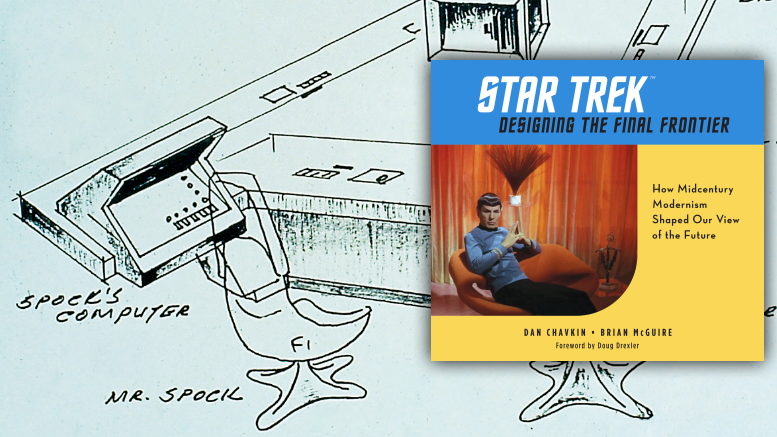

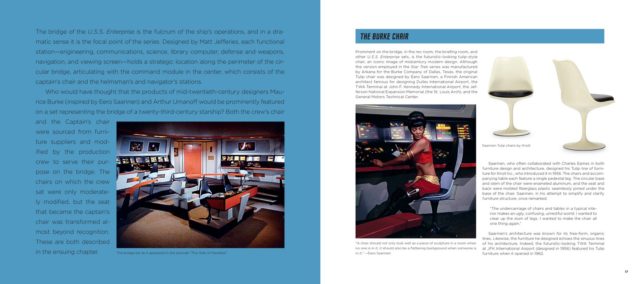
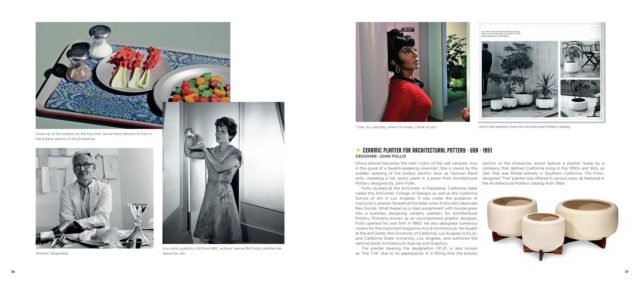
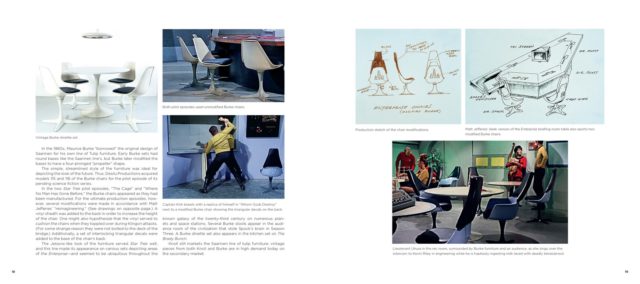
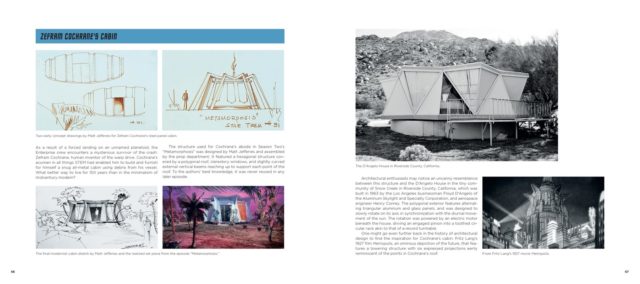
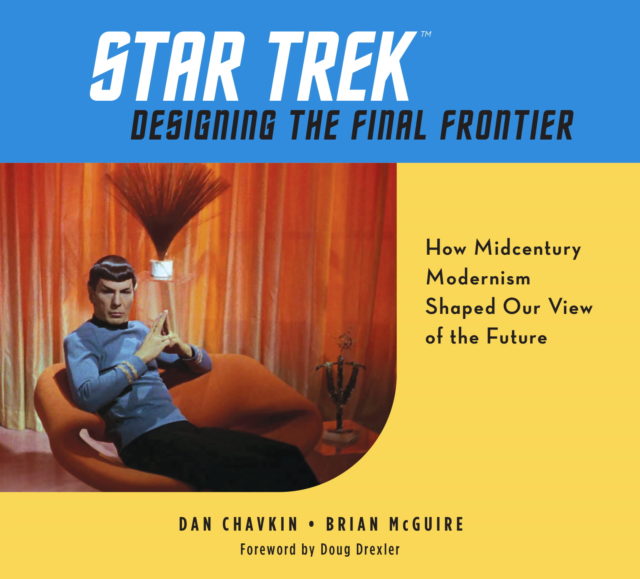
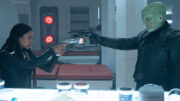


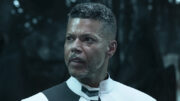
This looks amazing. Can’t wait to get my copy.
Great. The tulip chairs still look great today.
This is a wonderful idea for a book, but I think I’d be just as interested in what went into getting this into print. I literally cannot imagine how they were able to cut through the red tape to get the idea for this book approved, let alone securing the imagery.
This actually looks pretty cool.
The designs are cool. The only thing Star Trek always screws up is designs don’t ever match old shows,,, etc. At least go back and do another remaster where all matches up. The Constitution enterprise in Discovery looks higher tech than old series. This is where Entrprise series screwed up (well no Romulan War also)!
Well, it certainly wasn’t for the Romulans, in the series, lack of trying. Besides, there was a Temporal War that must have ultimately been either responsible for it being there in the first place or restoring it.
Well, the thing is…mid-century modern is no longer “modern.” It’s dated, not incredibly so, but it is definitely a 1950s/60s ethos, rather than a 21st-century ethos, and outside of purists, audiences don’t see sci-fi as a period piece. Compare, for instance, the look of the TWA terminal at JFK with new the Istanbul or Beijing or Berlin airports, or even Denver’s 1990s-era airport.
You can see some of the transition from mid-century to contemporary in films like 2001. But watch EX MACHINA to see what I’m talking about; that film really showcases contemporary interior design well.
Wow, Star Trek merch that I actually want to buy! :)
I enjoy interior design at the hobbyist level, something I’ve attributed to my love of Star Trek. I’ve loved the set design of all the Trek shows, but particularly the chairs. I’ve always wanted an Ospvik chair, like Lt. Worf had in his quarters, but have never found one with leather upholstery (making me perhaps the TNG designers modified Worf’s). They’re also pricey. :)
I have an area in my home that I think it appropriate for a circular table, and I am planning on getting a Saarinen tulip table and chair. (The tulip design shows up again in the Orville, too.)
Discovery also featured a modified Zuo Unico office chair in its S1 conference room, which I’m proud to say I bought before the series premiered! I chose this chair over an Eames (OK, Eames replica) chair; I like the look of Eames chairs, but they tend to sag. I also looked at an office chair showcased on the series OCCUPIED, which was a veritable cornucopia of Nordic design. I actually found the name of the set designer for that series and contacted him to learn the name of the chair’s designer, and nearly bought it, but went with the Zuo Unico for my home office instead.
I’m somewhat surprised that Le Corbusier chairs haven’t (to my knowledge) shown up in Star Trek. They’d fit the ethos well, particularly for the TOS period.
You should take a look at the chair designs that went unused in 2001 in THE 2001 FILE book from a few years back. I was really surprised that some of those didn’t get borrowed for ORVILLE or DSC or PICARD.
Thanks for the tip!
The Le Corbusier L7 chairs were in Wesley Crusher’s academy room in the First Duty I’m pretty sure… :)
I wonder if this gets distributes worldwide. Kinda looking forward to a copy.
This certainly is a book I’d love to read. I have a huge interest in interior design and architecture, and this looks to be a thoughtful analysis.
I’d love someone to do a similar book on Space: 1999. Many of the furniture and lighting pieces that were used are now classics from that era, and the modular interiors (complete with ceilings!) that could be “reshuffled” and lit in various colors depending on production and story requirements were pretty groundbreaking for TV at that time.
I think I need this. Then again, I need a lot of the recent books I haven’t gotten yet, alas…
Wow, totally going to have to get this!!